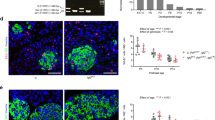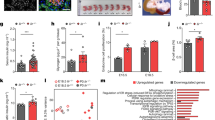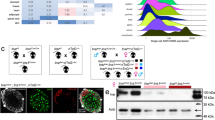Abstract
Insulin receptor substrates (Irs proteins) mediate the pleiotropic effects of insulin and Igf-1 (insulin-like growth factor-1), including regulation of glucose homeostasis and cell growth and survival. We intercrossed mice heterozygous for two null alleles (Irs1+/– and Irs2+/–) and investigated growth and glucose metabolism in mice with viable genotypes. Our experiments revealed that Irs-1 and Irs-2 are critical for embryonic and post-natal growth, with Irs-1 having the predominant role. By contrast, both Irs-1 and Irs-2 function in peripheral carbohydrate metabolism, but Irs-2 has the major role in β-cell development and compensation for peripheral insulin resistance. To establish a role for the Igf-1 receptor in β-cells, we intercrossed mice heterozygous for null alleles of Igf1r and Irs2. Our results reveal that Igf-1 receptors promote β-cell development and survival through the Irs-2 signalling pathway. Thus, Irs-2 integrates the effects of insulin in peripheral target tissues with Igf-1 in pancreatic β-cells to maintain glucose homeostasis.
This is a preview of subscription content, access via your institution
Access options
Subscribe to this journal
Receive 12 print issues and online access
$209.00 per year
only $17.42 per issue
Buy this article
- Purchase on Springer Link
- Instant access to full article PDF
Prices may be subject to local taxes which are calculated during checkout








Similar content being viewed by others
References
Cheatham, B. & Kahn, C.R. Insulin action and the insulin signaling network. Endocr. Rev. 16, 117– 142 (1995).
LeRoith, D., Werner, H., Beitner-Johnson, D. & Roberts, C. Molecular and cellular aspects of the insulin-like growth factor I receptor. Endocr. Rev. 16, 143–163 (1995).
Baserga, R., Hongo, A., Rubini, M., Prisco, M. & Valentinis, B. The IGF-I receptor in cell growth, transformation, and apoptosis. Biochem. Biophys. Acta 1332, F105–F126(1997).
Baserga, R. Oncogenes and the strategy of growth factors. Cell 79, 927–930 (1994).
White, M.F. & Kahn, C.R. The insulin signaling system. J. Biol. Chem. 269, 1–4 (1994).
Myers, M.G. Jr et al. IRS-1 is a common element in insulin and insulin-like growth factor-I signaling to the phosphatidylinositol3′-kinase. Endocrinology 132, 1421–1430 (1993).
Liu, J.P., Baker, J., Perkins, J.A., Robertson, E.J. & Efstratiadis, A. Mice carrying null mutations of the genes encoding insulin-like growth factor I (Igf-1) and type 1 IGF receptor (Igf1r). Cell 75, 59–72 (1993).
Accili, D. et al. Early neonatal death in mice homozygous for a null allele of the insulin receptor gene. Nature Genet. 12, 106–109 (1996).
Kulkarni, R.N. et al. Tissue-specific knockout of the insulin receptor in pancreatic β cells creates an insulin secretory defect similar to that in type 2 diabetes. Cell 96, 329–339 (1999).
Sun, X.J. et al. The expression and function of IRS-1 in insulin signal transmission. J. Biol. Chem. 267, 22662– 22672 (1992).
Sun, X.J. et al. Role of IRS-2 in insulin and cytokine signaling. Nature 377, 173–177 ( 1995).
Bernal, D. et al. Amino acid polymorphisms are not associated with random type 2 diabetes among Caucasians. Diabetes 47, 976–979 (1998).
Withers, D.J. et al. Disruption of IRS-2 causes type 2 diabetes in mice. Nature 391, 900–903 ( 1998).
Araki, E. et al. Alternative pathway of insulin signalling in mice with targetted disruption of the IRS-1 gene. Nature 372, 186–190 (1994).
Yamauchi, T. et al. Insulin signaling and insulin actions in the muscles and livers of insulin-resistant, insulin receptor substrate 1-deficient mice. Mol. Cell. Biol. 16, 3074–3084 (1996).
Tamemoto, H. et al. Insulin resistance and growth retardation in mice lacking insulin receptor substrate-1. Nature 372, 182–186 (1994).
Herrera, P.L. et al. Embryogenesis of the murine endocrine pancreas; early expression of pancreatic polypeptide gene. Development 113, 1257–1265 (1991).
LeRoith, D., Parrizas, M. & Blakesley, V.A. The insulin-like growth factor-I receptor and apoptosis. Implications for the aging process. Endocrine 7, 103–105 (1997).
Yenush, L., Zanella, C., Uchida, T., Bernal, D. & White, M.F. The pleckstrin homology and phosphotyrosine binding domains of insulin receptor substrate 1 mediate inhibition of apoptosis by insulin. Mol. Cell. Biol. 18, 6784– 6794 (1998).
Scaglia, L., Smith, F.E. & Bonner-Weir, S. Apoptosis contributes to the involution of β cell mass in the post partum rat pancreas. Endocrinology 136, 5461–5468 (1995).
Scaglia, L., Cahill, C.J., Finegood, D.T. & Bonner-Weir, S. Apoptosis participates in the remodeling of the endocrine pancreas in the neonatal rat. Endocrinology 138, 1736– 1741 (1997).
Datta, S.R. et al. Akt phosphorylation of BAD couples survival signals to the cell-intrinsic death machinery. Cell 91, 231–241 (1997).
Bruning, J.C., Winnay, J., Cheatham, B. & Kahn, C.R. Differential signaling by insulin receptor substrate 1 (IRS-1) and IRS-2 in IRS-1 deficient cells. Mol. Cell. Biol. 17, 1513– 1521 (1997).
Rother, K.I. et al. Evidence that IRS-2 phosphorylation is required for insulin action in hepatocytes. J. Biol. Chem. 273, 17491–17497 (1998).
Velloso, L.A., Carneiro, E.M., Crepaldi, S.C., Boschero, A.C. & Saad, M.J. Glucose- and insulin-induced phosphorylation of the insulin receptor and its primary substrates IRS-1 and IRS-2 in rat pancreatic islets. Growth Regul. 377, 353 –357 (1995).
Schuppin, G.T. et al. A specific increased expression of insulin receptor substrate 2 in pancreatic β-cell lines is involved with mediating serum-stimulated β-cell growth. Diabetes 47, 1074– 1085 (1998).
Hugl, S.R., White, M.F. & Rhodes, C.J. IGF-1 stimulated pancreatic β-cell growth is glucose dependent: synergistic activation of IRS-mediated signal transduction pathways by glucose and IGF-1 in INS-1 cells. J. Biol. Chem. 273, 17771–17779 (1998).
Sawka-Verhelle, D. et al. Tyr624 and Tyr628 in insulin receptor substrate-2 mediate its association with the insulin receptor. J. Biol. Chem. 272, 16414–16420 (1997).
Sawka-Verhelle, D., Tartare-Deckert, S., White, M.F. & Van Obberghen, E. Insulin receptor substrate-2 binds to the insulin receptor through its phosphotyrosine-binding domain and through a newly identified domain comprising amino acids 591–786. J. Biol. Chem. 271, 5980– 5983 (1996).
Vaisse, C., Kim, J., Espinosa, R. III, Lebeau, M.M. & Stoffel, M. Pancreatic islet expression studies and polymorphic DNA markers in the genes encoding hepatocyte nuclear factor-3×, -3β, -3γ, -4γ, and -6. Diabetes 48 , 1364–1367 (1997).
Ahlgren, U., Jonsson, J., Jonsson, L., Simu, K. & Edlund, H. β-cell-specific inactivation of the mouse Ipf1/Pdx1 gene results in loss of the β-cell phenotype and maturity onset diabetes. Genes Dev. 12, 1763–1768 (1998).
Edlund, H. Transcribing pancreas. Diabetes 47, 1817 –1823 (1998).
Sharma, S. et al. Hormonal regulation of an islet-specific enhancer in the pancreatic homeobox gene STF-1. Mol. Cell. Biol. 17, 2598–2604 (1997).
Guz, Y. et al. Expression of murine STF-1, a putative insulin gene transcription factor, in β cells of pancreas, duodenal epithelium and pancreatic exocrine and endocrine progenitors during ontogeny. Development 121, 11–18 (1995).
Baker, J., Liu, J.P., Robertson, E.J. & Efstratiadis, A. Role of insulin-like growth factors in embryonic and postnatal growth. Cell 75, 73–82 ( 1993).
Swenne, I. Pancreatic β-cell growth and diabetes mellitus. Diabetologia 35, 193–201 ( 1992).
Acknowledgements
We thank A. Efstratiadis for Igf1r+/– mice; B. Cheatham for anti-IRβ antibodies; and J. Marron for assistance in preparation of this manuscript. This work was supported by DK43808. D.J.W. is an MRC (UK) Clinician Scientist and D.J.B. was supported by a grant from the JDFI during a portion of these studies.
Author information
Authors and Affiliations
Corresponding author
Rights and permissions
About this article
Cite this article
Withers, D., Burks, D., Towery, H. et al. Irs-2 coordinates Igf-1 receptor-mediated β-cell development and peripheral insulin signalling. Nat Genet 23, 32–40 (1999). https://doi.org/10.1038/12631
Received:
Accepted:
Issue Date:
DOI: https://doi.org/10.1038/12631
This article is cited by
-
IGF-1 ameliorates streptozotocin-induced pancreatic β cell dysfunction and apoptosis via activating IRS1/PI3K/Akt/FOXO1 pathway
Inflammation Research (2022)
-
Differential gene expression in liver of colored broiler chicken divergently selected for residual feed intake
Tropical Animal Health and Production (2021)
-
Wisp1 is a circulating factor that stimulates proliferation of adult mouse and human beta cells
Nature Communications (2020)
-
The influence of the lack of insulin receptor substrate 2 (IRS2) on the thyroid gland
Scientific Reports (2019)
-
Multiple therapeutic effect of endothelial progenitor cell regulated by drugs in diabetes and diabetes related disorder
Journal of Translational Medicine (2017)



